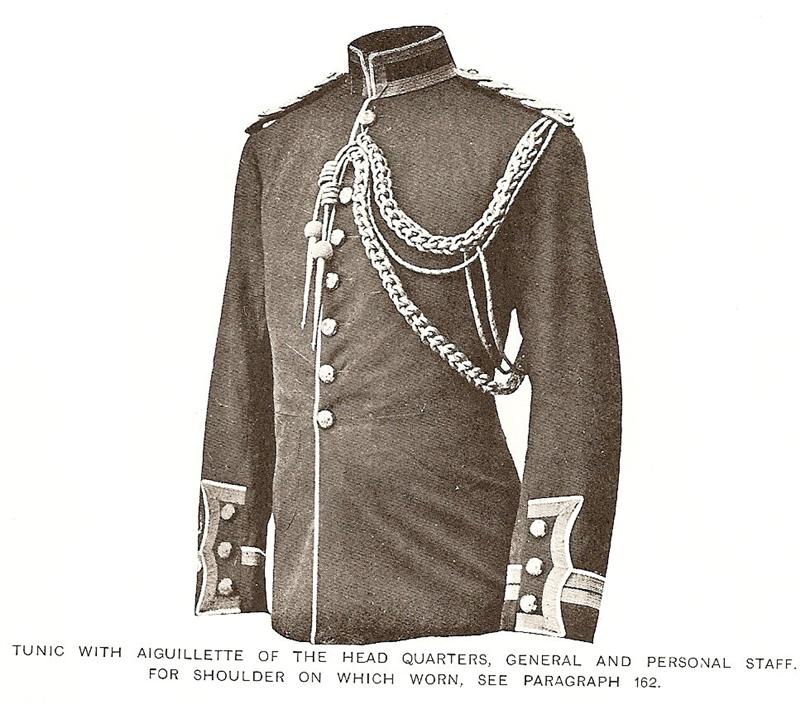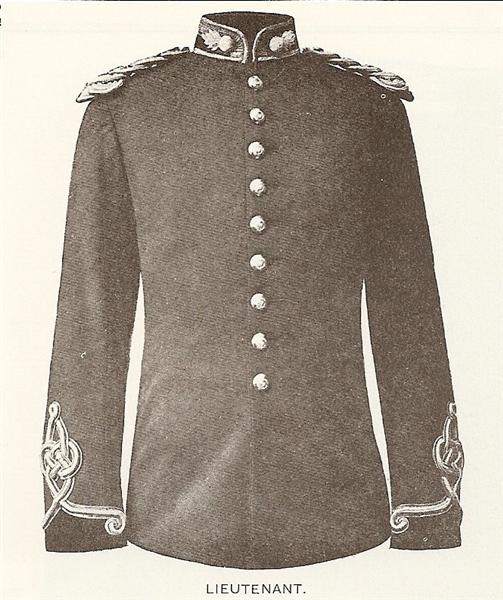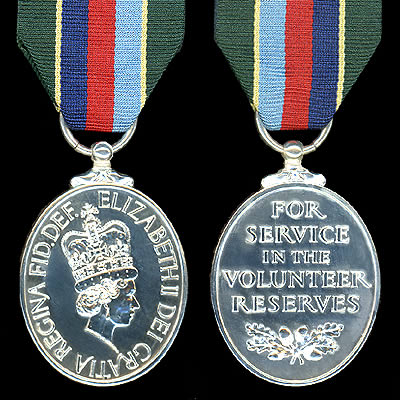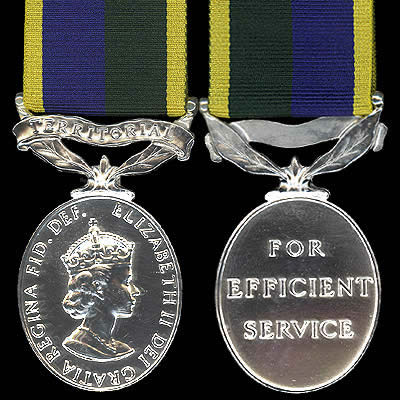-
Posts
1,065 -
Joined
-
Last visited
-
Days Won
1
Content Type
Profiles
Forums
Blogs
Gallery
Events
Store
Posts posted by Graham Stewart
-
-

Description of the "aiguillette" from Dress Regulations 1900.
Graham.
 0
0 -

The aiguillette wouldn't appear to be out of place if attached to the General Staff as Personal Staff, and is worn as illustrated by officers on the left side below a certain rank.
Graham.
 0
0 -

This is obviously the tunic in your possession, but I'm unable to find anything in Dress Regulations regarding the shoulder belt. Had it been cavalry, a pouch would have been attached. That for the Royal Engineers was of "Russian leather, 2inches wide, with three stripes of gold embroidery, the centre one being waved, the others straight; engraved buckle, tip and slide. The letters R.E. within the tip".
Graham.
 0
0 -
Gordon,
Not actually sure where the double of service for T.A. lads came from so I'll check my T.F.Regulations for 1908 & 1912, although any later Army Orders regarding this won't be included. I'm certain though that when I was in from 1986 - 2000 that the doubling rule was still included as we had some members who had served in Northern Ireland and 1st Gulf War, who also received the G.S.M. and Gulf Medals, but also doubled their service for it.
Going back to the T.E.M., it wasn't really regarded as a long service medal as some lads had been in a lot longer than myself, but had no T.E.M.. This was because for one reason or another they hadn't been returned "efficient" during their terms of service. It was something like 12years service, 12 annual camps or courses in lieu and returned "efficient" on no less than 10 occassions during that period. I can't remember the exact terms, but it was something like that or 10 camps and 12 years efficient.
Now my understanding is that the V.S.M. is for only ten years service without being returned as "efficient", which would indeed place it as a "long service decoration", rather than an efficiency medal. Looking back on it my own T.E.M. really is something of a rarity and must rank as one of the last ever given out, plus it had be made obsolete in 1992 and mine came along in 1998!!!
All of this is actually covered under Queens Regulations for the T.A., so if you can get hold of a copy you'll find some interesting reading in them.
Graham.
0 -
Looks like you'll have to invest in a digital camera, a most useful tool in this game. Ironically I bought my first one in Florida after loosing our old camera at Disney World and haven't looked back since.
The Rifle Grey tunic is infact British and belongs to the 4th Bn, Northumberland Fusiliers(T.F.), and the colour dates back to the early Rifle Volunteer days of 1860, when greys and greens were more common than scarlet. It's a 1909 pattern tunic, that seems to be unique to the Territorial Force as there's subtle differences to it.
Now this is just an observation, but there appears to be no gold lace on your tunic which there should be if it's an officers pattern. This would be found on both the collar, shoulder boards and Austrian knott on the cuff.
Graham.
0 -
Bigjar,
I think the only way that they could end up wearing two medals, of exactly the same purpose is because the bar is no longer available for the T.E.M., as it's now obsolete. To get the V.S.M., they would have to put in an additional ten years efficient service on top of the previous twelve years for the T.E.M., so in effect they must have had twenty two years T.A. service.
However there used to be a ruling whereby if you actually did 'active service' as a member of the T.A., your 'active service' time would be doubled towards your T.A. service. For instance if you did a six months or one years active service with the regulars, then you would infact have accumulated 1 & 2 years T.A. service respectively.
This same system was used during both the Great War and WWII, so that a T.F. lad surving the fours years carnage on the Western Front would in effect have done eight years accumulated service.
Confusing eh?
Graham.
0 -

The Volunteer Services Medal, which replaced the T.E.M. in 1992. Now here's a poser my medal (T.E.M.) wasn't awarded until 1998 and yet by all accounts it's this medal I should have been awarded?? Was this the other medal being worn by the 'old & bold' among your T.A. colleagues??
Graham.
 0
0 -

The T.E.M. as it was until 1992 when it was replaced. Post 1968 the bar had "T.A. & V.R." but seems to have been replaced by the traditional T.E.M.
Graham.
 0
0 -
Not a 100% certain of this but wasn't the distinguishing medals for the T.A., R.N.R. and R.A.F.V.R. replaced some years ago by a single "Reserve Forces Medal". I'm ex-T.A. myself and was awarded the Territorial Efficiency Medal, which carries the wording "Territorial" on a scroll above the leaves.
Now technically whether or not you're entitled to wear both would be a matter for Queens Regulations, but an officer of the T.A. who was to receive a 'T.E.M.', while serving as another rank, would be allowed to wear it when commisioned, until such time that he was due to be awarded his bar. He would then have to replace the T.E.M. with a 'Territorial Decoration. and Bar', as he's not allowed to wear both.
Graham.
0 -
TS,
The picture alas is pretty small, so we can't really make out a lot of features, but one thing is for certain don't go selling of the additional bits as they may just be part of the uniform as officers wore a number of dress distictions around their scarlet jackets. For instance "parade dress" would differ from that worn at "court". By that I don't mean where a judge bangs you in jail, I mean the 'Royal court'. Officers who were also A.D.C. to higher ranking officers or the Royal Household would also wear dress distinction fitting that role and so on. What you actually require is a copy of Dress Regulations for the period which gives all of the dress distinctions for officers.
Graham.
PS,
Any chance of some clearer larger photos like the attached?

 0
0 -
Brian,
Looked on the National Archive online Medal Index Cards and your man served during the Great War and the '820804' number is a post 1917 T.F. number for the North Midland Division. It also gives us his pre-1917 number which is '17'. See the link below;-
http://www.nationalarchives.gov.uk/documen...p;resultcount=2
However this '17' may not be his original number on enlistment into the T.F. as the Ammunition Columns were formed from all of the Batteries serving in the Brigade and as such all were renumbered on the formation of the Column. The only reason I know this is because my own grandfather was in an Ammo Column and he too was renumbered on it's formation and again in 1917, but I didn't know of his original number until reading his service papers.
Graham.
0 -
The figures themselves actually come from H.M.Government and were used in Gregory Blaxlands "The Regiments Depart - A History of the British Army 1945-1970", which is possibly one of the best books I've ever read on the post WWII British Army and it's subsequent campaigns.
British and Gurkha casualties for the Malayan Campaign 1948 - 1961 are also given as;-
British units;-
Killed
60 officers & 280 O/R's.
Wounded
77 officers & 536 O/R's
Gurkha units;-
Killed
20 officers & 149 O/R's
Wounded
30 officers & 278 O/R's
Graham.
0 -
Now curiosity has the better of me here as the number on the medal isn't one that you'd normally find on a T.F.E.M., as prior to 1917 they only had four figure numbers. Now as this has a six figure number 820804, it's been issued post 1917 and it's recipient was actually serving with the North Midland Division Ammunition Column, which was made up of men from the Royal Field Artillery(T.F.).
Graham.
0 -
The Malayan Campaign from 1954 to 1960 was regarded as the 'Mopping -Up' period, with the Communist Terrorists regarded as a spent force. The number of killed from C.T. activity from 1948 to 1950 were;-
863 civilians.
323 Policemen.
154 Soldiers
For 1951
532 civilians.
381 Policemen.
108 Soldiers,
For 1952
342 civilians.
207 Policemen.
77 Soldiers.
For 1953
84 civilians.
29 Policemen.
34 Soldiers.
I'm no tactician, but going off these Government figues alone it show's the campaign had peaked long before 1957 and was in a run down period from 1954, due to the success of those who actively took part in eliminating C.T. units. There again "ours is not to reason why, ours is but to do or die", when others make up the rules for gongs.
Graham.
0 -
Who's the recipient, which should be on the rim.
Graham.
0 -
Definately a 'farrier' and if you closely at the lower cuff on the same arm you'll see his overseas service chevrons. The lad sat next to him also has them.
Graham.
0 -
What hacks me off about the award of this medal is that no-one who served in Malaya prior to 1957 is entitled to it, when funnily enough thats when the bulk of the fighting was done. Not that it would bother him, as he died seven years ago, but my old man was out there with the Grenadier Guards during the Emergency from September 1948 to August 1949 and although he does have the G.S.M. with the 'Malaya' clasp, it would have been a nice gesture if the Malayan Government had extended it's issue to all Malaya veterans.
Graham.
0 -
Looking at this one there's no doubt in my mind that someone was being placed on "a charge", hence the presence of the Red Cap(R.M.P.).
Graham.
0 -
Christer,
I'm as wise as you are as to what a 'strapper' did, but it was classed as a trade in both the Army and civvy street.
The British and Empire Silver War Badges are covered within this Forum here;-
http://gmic.co.uk/index.php?showtopic=13142.
I also posted a couple of certificates which were presented with the badges, which were given for 'Services Rendered', not specifically for wounds or overseas service. They would more likely be issued to a man who was discharged under Kings Regulations Paragraph 392(xvi) being "no longer physically fit for war service".
So if he wasn't discharged under KR's 392(xvi) then it's unlikely he would get one.
Graham.
0 -
This may or may not be correct, but I'm a member of the Great War Forum also which has a lot of people who are into the ASC and it's prefixes and taking your mans regimental number T2/SR/01743, it possibly means this
T2 = Horse Transport(2nd New Army).
SR - Strapper Remounts.
01743 = Regimental number.
Noted on your downloaded MIC that the initials had been changed from SB to SR, and apparently 'S' was a trade called 'Strapper' and 'R' was 'Remounts' within the ASC.
On a similar note I picked up some paperwork today for an ASC man whose number was TS/3934 and this means Horse Transport(T) Strapper(S). On one piece of paperwork it does actually say his civilian trade is 'strapper'.
Graham.
0 -
Certainly looks as though it's a sun bleached example of the Royal Signals. The only way to tell would be to remove it and look at the reverse as the colouring should remain stable on the other side. I picked up RAF pagree flash some years ago in York for a RAF collector friend and it was bleached, but not as bad. the reverse side though was perfect.
Graham.
0 -
Ed,
If you can find out where the flashes are, then I think it would be of great interest to our friends here who collect or research our Indian connections, certainly if they were pre-1947, as you would certainly be looking at the Indian Home Divisions and possbly mixed Indian/British Brigades. Might be worth checking if they have any catalogues recording regimental pagaree flashes too.
Graham.
0 -
Stuart,
To be honest 'no', it's one I've never touched on being interested mainly in infantry. The Brian L. Davis, book I've had since it first appeared on the market in 1983 and today this it's still regarded as a 'bible' among WWII uniform enthusiasts. The lad did something that many authors fail to do and that was go through every ACI and AO regarding dress/ranks and insignia - the end result being a first class record of what was 'in' and what was 'out'. I think it'll only ever be surpassed if Joe Sweeney publishes a book on British Army service dress taking us up to WWII, as I believe he's recently gone through the same sources covering dress/rank & insignia, so I keep my fingers crossed.
Recently at a Militaria fair I saw one of those books which make you 'gasp' and although modern by many standards, I wished every regiment had put one into print. It was a 1960's publication regarding dress and accoutrements for the 3rd Carabiniers, which was stuffed with line drawings of every item worn by the regiment. Absolutely fantastic and left on the shelf because no-one was interested.
Graham.
0 -
Stuart,
Correct any School flashes would differ from active units, but it's parent unit would control dress. In this case I'm slightly confused as to why it's called the Royal Armoured Car School, should it not just be the "Armoured Car School", which at this time I suspect was run by the Royal Tank Corps, from which two of the colours on the flash derive.
The Royal Armoured Corps wasn't formed until 1939 and and the Royal Tanks Corps became the 'Royal Tank Regiment' at the same time(A.O.58/1939).
Also I've found a decent reference regarding flashes in 'British Army Uniforms & Insignia of WWII' by B.L.Davis all of which are taken from ACI's and AO's. If you haven't got this them let me know and I'll forward it to you via e.mail.
Graham.
0




Cawnpores and Bombay Bowlers
in Great Britain: Militaria: Badges, Uniforms & Equipment
Posted
A red hackle only would also be Black Watch, which was worn with the khaki Foreign Service helmet and the khaki solar pith helmet. The Coldstreams wore theirs on the right side of the Foreign Service helmet as opposed to the left by most of the other hackle wearing units.
Graham.